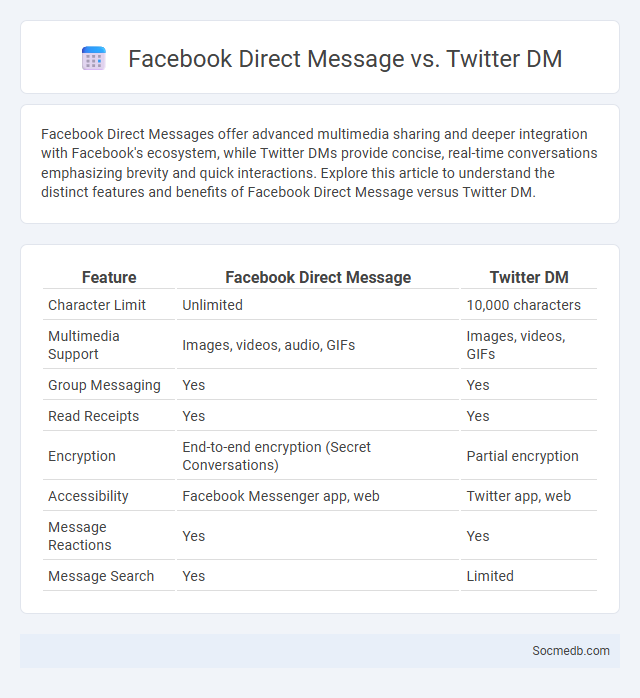
Photo illustration: Facebook Direct Message vs Twitter DM
Facebook Direct Messages offer advanced multimedia sharing and deeper integration with Facebook's ecosystem, while Twitter DMs provide concise, real-time conversations emphasizing brevity and quick interactions. Explore this article to understand the distinct features and benefits of Facebook Direct Message versus Twitter DM.
Table of Comparison
| Feature | Facebook Direct Message | Twitter DM |
|---|---|---|
| Character Limit | Unlimited | 10,000 characters |
| Multimedia Support | Images, videos, audio, GIFs | Images, videos, GIFs |
| Group Messaging | Yes | Yes |
| Read Receipts | Yes | Yes |
| Encryption | End-to-end encryption (Secret Conversations) | Partial encryption |
| Accessibility | Facebook Messenger app, web | Twitter app, web |
| Message Reactions | Yes | Yes |
| Message Search | Yes | Limited |
Overview of Direct Messaging on Social Platforms
Direct messaging on social platforms enables private, real-time communication, enhancing user engagement and relationship building. Platforms like Instagram, Facebook, and Twitter offer integrated messaging features that support text, images, and multimedia sharing securely. Your ability to leverage direct messaging tools boosts personalized interaction, driving stronger connections and more effective social media marketing strategies.
What is Facebook Direct Message?
Facebook Direct Message is a private messaging feature within the Facebook platform that allows users to send text, images, and videos directly to individuals or groups without posting publicly. This tool enhances personal communication by enabling real-time interaction and secure conversations tailored to your social network. Using Facebook Direct Message, you can share updates, coordinate plans, or maintain privacy while engaging with friends and contacts.
Understanding Twitter DM
Twitter DM (Direct Message) enables private communication between users, with features supporting text, images, videos, and links for enriched interaction. You can manage your privacy settings to control who can send you DMs, enhancing your security and user experience. Understanding message request filters and group DM options helps optimize your use of Twitter's private messaging capabilities.
Defining ‘Direct Message’ Across Platforms
Direct Message (DM) refers to a private communication feature available on various social media platforms such as Twitter, Instagram, and Facebook. These messages allow users to exchange texts, images, and videos securely without public visibility, enhancing personal and professional interactions. Understanding platform-specific DM functionalities, like message requests on Instagram or tweet replies in private on Twitter, is essential for effective and confidential communication.
User Interface Comparison: Facebook vs Twitter DM
Facebook's direct messaging interface offers a comprehensive layout with threaded conversations, multimedia sharing, and integrated reactions, enhancing user interaction. Twitter DM emphasizes simplicity, featuring a streamlined chat window optimized for quick text exchanges and seamless integration with tweet sharing. Both platforms prioritize real-time communication but differ in complexity and user experience design tailored to their user base.
Privacy and Security Features
Social media platforms offer advanced privacy and security features designed to protect your personal information and online interactions. Customizable settings allow you to control who can view your posts, manage friend requests, and limit data sharing with third-party apps. Robust encryption and multi-factor authentication enhance account security, reducing the risk of unauthorized access and cyber threats.
Message Delivery and Notification Systems
Social media platforms utilize advanced message delivery and notification systems to ensure real-time communication and user engagement. These systems employ push notifications, in-app alerts, and personalized content algorithms to deliver relevant updates instantly. Optimizing message latency and reliability enhances user experience and drives platform interaction metrics.
Multimedia and File Sharing Capabilities
Social media platforms excel in multimedia and file sharing capabilities, enabling users to upload, edit, and share photos, videos, and audio files seamlessly. These platforms support high-resolution media formats and integrate with cloud storage solutions to ensure fast and secure content delivery. Your ability to effortlessly share diverse media types enhances engagement and broadens your digital reach.
Use Cases: Personal vs Business Direct Messaging
Social media direct messaging offers distinct advantages for personal and business use cases, enhancing user engagement and communication efficiency. Personal messaging prioritizes instant, informal exchanges, fostering close connections through multimedia sharing, while business direct messaging leverages targeted outreach, personalized customer support, and lead generation to drive sales and brand loyalty. Optimizing your social media strategy requires understanding these differences to tailor messages that resonate with your audience and achieve specific goals.
Choosing the Right Direct Messaging Platform
Selecting the right direct messaging platform depends on factors like user demographics, security features, and integration capabilities with existing tools. Platforms such as WhatsApp, Facebook Messenger, and Slack offer varying degrees of encryption, multimedia support, and automation options tailored for personal or business communication. Analyzing these criteria ensures efficient, secure, and user-friendly interactions that align with specific messaging goals.
 socmedb.com
socmedb.com